Apollinary Vasnetsov
Apollinary Mikhaylovich Vasnetsov (Russian: Аполлина́рий Миха́йлович Васнецо́в; August 6, 1856 – January 23, 1933) was a Russian painter and graphic artist whose elder brother was the more famous Viktor Vasnetsov.[1] He specialized in scenes from the medieval history of Moscow.
Apollinary Vasnetsov | |
|---|---|
Аполлинарий Михайлович Васнецов | |
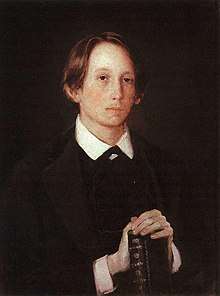 Vasnetsov. Portrait by his brother, Viktor (1878) | |
| Born | July 25, 1856 |
| Died | January 23, 1933 (aged 76) |
| Education | Member Academy of Arts (1900) |
| Alma mater | Moscow School of Painting |
| Known for | Painting |
| Movement | Peredvizhniki |
Vasnetsov did not receive a formal artistic education. He studied under his older brother, Viktor Vasnetsov, the famous Russian painter. From 1883, he and his brother lived and worked in Abramtsevo where he fell under the influence of Vasily Polenov. In 1898–1899, he travelled across Europe. In addition to epic landscapes of Russian nature, Apollinary Vasnetsov created his own genre of historical landscape reconstruction on the basis of historical and archaeological data. His paintings present a visual picture of medieval Moscow. He was a member of the Association of Travelling Art Exhibitions (Peredvizhniki) from 1899, and an academician from 1900. He became one of the founders and supervisors of the Union of Russian Artists.
Early life
The future painter had three elder and two younger brothers. Their only sister died at the age of four months. Their father played an important role in the upbringing and education of his sons. He taught them to love nature and to become familiar with the life of birds and animals. The death of his father in 1870 was a terrible blow for Vasnetsov.
The Caucasus and the Urals
In 1890, he made a journey across the North of the Russian Empire. Beautiful views of Siberia and the Urals were captured by Apollinary Vasnetsov in a large number of his canvasses, including:
- Forest on the Slopes of Mount Blagodat, Mid-Urals (1890)
- Boreal forest in the Urals (1890)
- Mountain lake in the Urals (1892)
- The Steppes of Orenburg (1895)
- "Koma" (1895)
In 1895, Vasnetsov visited the Caucasus. He was deeply impressed by the beauty of the rugged Caucasus mountains. Whilst there, he climbed the glaciers of Mt. Elbrus, visited Tiflis and lived in the Darial Gorge. He created a great number of his sketches during this period, including:
- View of Elbrus from Bermomut (1895)
- Red Cliffs in Kislovodsk (1896)
- Elbrus before Sunrise (1897)
- Darial (1897)
In 1890, he made a journey across Europe, visiting France and Italy, where he studied the works of famous masters.
At the beginning of 1920, the Committee of Archaeology (the predecessor of the Community for the Saving of Art Monuments) invited Apollinary Vasnetsov and some other painters (including Vikentii Trofimov) to draw the old places of Voronezh.
A minor planet, 3586 Vasnetsov, discovered by Soviet astronomer Lyudmila Zhuravlyova in 1978, is named after Viktor Vasnetsov and Apollinary Vasnetsov.[2]
Gallery
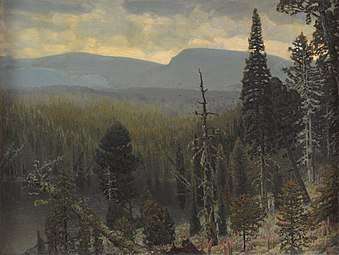 Boreal forest in the Ural mountains
Boreal forest in the Ural mountains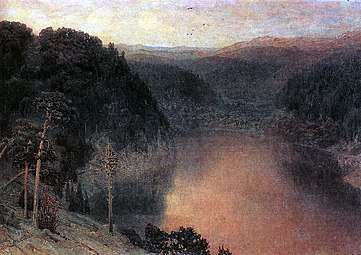 Mountain Lake (1892)
Mountain Lake (1892)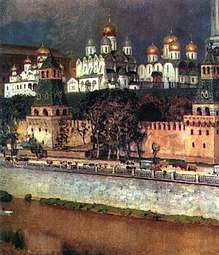 Kremlin (1892)
Kremlin (1892)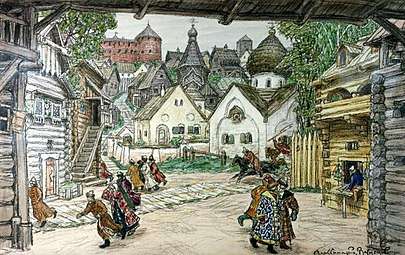 Set for the opera The Oprichnik by Tchaikovsky (1911)
Set for the opera The Oprichnik by Tchaikovsky (1911)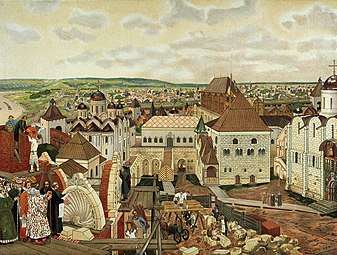 In the Moscow Kremlin
In the Moscow Kremlin- Novgorod marketplace
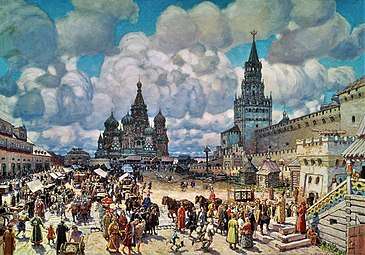 Red Square in the second half of the 17th century
Red Square in the second half of the 17th century Kama River
Kama River
See also
References
- "Apollinary Mikhaylovich Vasnetsov | Russian artist". Encyclopedia Britannica. Retrieved 2018-08-18.
- Schmadel, Lutz D. (2003). Dictionary of Minor Planet Names (5th ed.). New York: Springer Verlag. p. 301. ISBN 3-540-00238-3.
Sources
- Apollinary Vasnetsov by Vasnetsova, Yekaterina & Schmidt, Igor (eds.), Izobrazitelnoye Iskusstvo, Moscow, 1980, (Russian/English), Book ID V 1121 31.
- Great painters by Gordeeva M., "Direct media", Kiev, 2011, (Russian)
Further reading
| Wikimedia Commons has media related to Apollinary Vasnetsov. |